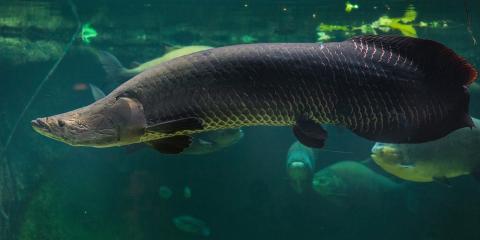Physical Description
The overall color is russet brown to black, and there are distinct spines on the third and fourth pair of legs. The tarantula's fangs fold under the body, meaning that it must strike downwards to impale its prey. Tarantulas have four pairs of legs, or eight legs total. In addition, they have four other appendages near the mouth called chelicerae and pedipalps. The chelicerae contain fangs and venom, while the pedipalps are used as feelers and claws; both aid in feeding. The pedipalps are also used by the male as a part of reproduction.
Size
The Goliath bird-eating tarantula is the biggest tarantula in the world. The body measures up to 4.75 inches (12 centimeters) with a leg span of up to 11 inches (28 centimeters).
Native Habitat
The Goliath bird-eating tarantula lives in the rainforest regions of northern South America, including Venezuela, northern Brazil, Guyana, French Guiana and Suriname. It lives in the deep rainforest, in silk-lined burrows and under rocks and roots.
Lifespan
Their lifespan can be from 10 to 15 years in human care. Females can live up to 20 years, but males only live between 3 and 6 years.
Communication
If they need to defend themselves, they rub hairs together to create a hissing noise loud enough to be heard 15 feet away. They can also let their hairs loose and fling them at attackers. The goliath bird-eating spider may also rear up on its hind legs to show its large fangs as a further defense strategy.
Food/Eating Habits
As its name suggests, this species can eat birds and just about anything that is smaller than it is, including invertebrates and mice, frogs, lizards and birds.
At the Smithsonian's National Zoo, they eat cockroaches.
Sleep Habits
The Goliath bird-eating spider is mostly active at night.
Social Structure
The Goliath bird-eating spider is generally solitary, and individuals only come together to mate.
Reproduction and Development
After their maturation molt, males develop a "finger" on the underside of the first set of front legs that is used to hook and lock the female's fangs and to steady themselves while they mate. After mating, males die within a few months.
The female must have recently molted in order to reproduce, or acquired sperm will be lost during the molt. Once mated, the female makes a web in which she lays 50 to 200 eggs that become fertilized as they pass out of her body. The female then wrap the eggs into a ball, and, unlike other species of tarantula, the female carries the egg sac with her. Egg sacs are almost the size of a tennis ball and contain around 70 spiderlings.
In order to grow, they must go through several molts. Molting is the process by which the tarantula sheds its old exoskeleton and emerges in a new, larger one. Spiderlings can be expected to molt five or six times in their first year. They take around two to three years to reach maturity.
Help this Species
- Are you a student? Did you love what you learned about this animal? Make it the topic of your next school project, or start a conservation club at your school. You'll learn even more and share the importance of saving species with classmates and teachers, too.
- Less is more. Cut down on the demand for resources by consuming less. Buy only what you need, and look for pre-owned or repurposed items before purchasing something brand new.


